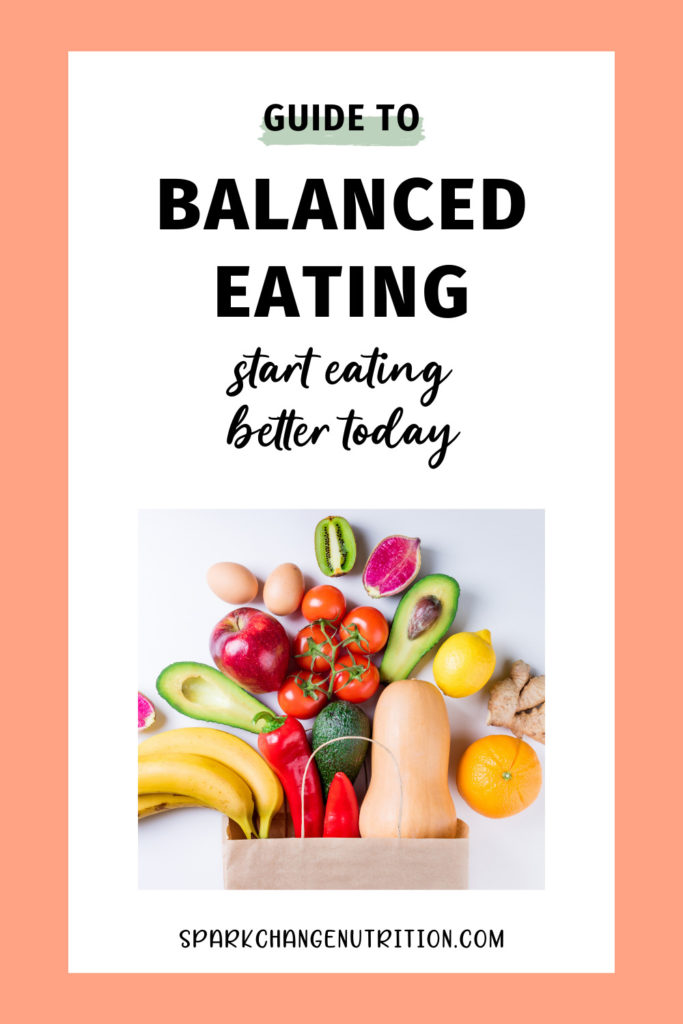If you’ve ever wanted to eat better but weren’t sure where to begin, then you’ve come to the right place. In this post I’ve compiled answers to several FAQ related to balanced eating.

What does “balanced eating” mean?
Balanced eating can mean different things to different people. For the purposes of this blog post, I’m going to defer to the definition used by author Michael Pollan in his book In Defense of Food:
Eat food. Not too much. Mostly plants.1
I love this quotation! In just three short sentences, Pollan is able to capture the essence of a balanced diet. He does this by focusing on two key diet characteristics: quantity and quality.
Your diet quantity should be moderate. Eat enough to feel full, but not overstuffed. Don’t let yourself get too hungry, and don’t deprive yourself of food when your body truly needs it.
At the same time, your diet quality should be as nutrient-dense as possible. It should consist mostly of “food”, which Pollan distinguishes from “food-like substances,” or highly processed foods. Your diet should also primarily come from plants, because plants are lower in calories and higher in vitamins, minerals, and fiber than animal products.1
What should I know about nutrition?
Nutrition is an interesting and complex discipline, and no one could possibly explain all you need to know in a single blog post. The science of nutrition is also nuanced, and the conclusions drawn by research studies can be complicated or conflicting. Even as a dietitian, it is sometimes difficult to know the “right” answer to a nutrition question.
In spite of that, there are some basic principles that everyone agrees on and that merit an explanation here: nutrients, food groups, and calories.
What are nutrients?
Our body needs a variety of substances in order to function normally. These substances are found in the foods we eat, and we are able to access them via the process of digestion and absorption. They are classified into six groups:
- Carbohydrates
- Fats
- Proteins
- Vitamins
- Minerals
- Water
The first three nutrients (carbs, fats, and protein) all provide energy in the form of calories. The latter three (vitamins, minerals, and water) do not contain calories. We need all of these nutrients in varying proportions depending on factors like our age, gender, and body size. I will go into more detail on these in a later post.2
What are the food groups?
While our bodies need the nutrients from food to function properly, those nutrients are too small to see with the naked eye. You can’t pick up a single carbohydrate and eat it, nor can you consume a single milligram of calcium. The food groups are a way of translating those microscopic nutrients into collections of foods that we can see and understand. The basic food group categories are:
- Fruits
- Vegetables
- Grains
- Protein foods
- Dairy products
In order to achieve balanced eating, you want to eat a variety of foods, both within and across food groups. If you visit the MyPlate website, you can type in your info and find out how much of each food group to eat each day. If you are a parent, you can also do this for your kiddos. (I have done this on occasion, and it is helpful to get a reminder of how much of everything my kids should be eating.)

What are calories?
If you’ve ever taken a physics or nutrition class, you may have learned the technical definition of a calorie:
One calorie is the amount of energy needed to raise the temperature of 1 gram of water by 1 degree Celsius.2
This definition doesn’t really make sense in day-to-day life, however. I like to say that calories are just a representation of the amount of energy that the body receives from eating a particular food. Alternatively, they can also represent the amount of energy you expend doing a particular task.
Since I am getting a little detailed, I will also mention that the word “calorie” used on food labels is actually shorthand for a kilocalorie, or 1000 calories. It should technically be written with a capital C (as in “Calorie”). But since that’s not how people commonly write it, I won’t do that here.3
How many calories should I eat?
This question does not have a completely straightforward answer, as each person is different and has a different body type and metabolism. (You will find that individualized nutrition is a theme on my blog.) Two people may be the same height and weight but have very different calorie needs depending on how old/active/muscular they are.
In fact, there are a lot of different ways to calculate your calorie needs. They range from specific equations used in the hospital setting to general guidelines published by the government. Because this is a blog, I will be explaining the general guidelines. Not only are they the most generalizable, they are also the easiest to quantify and follow.
Here are a few quick and easy ways to determine your ballpark calorie needs:
- Visit the MyPlate website and enter a few pieces of demographic information to get your MyPlate Plan. It will provide you will a personalized downloadable plan, which includes a suggested calorie level. It will also tell you how many foods from each food group to eat each day.
- Use this table from the USDA.
It’s important to remember that learning how many calories you “should” eat need not be the end-all and be-all when it comes to making food choices. I personally focus more on eating foods from the different food groups versus counting calories.
How can you tell what is a myth and what is factual nutrition information?
This can be a tough question to answer, even for a dietitian! There is just so much information out there, and a lot of it conflicts with each other. Here’s what I do to tease out the myths vs the facts.
To start, I recommend looking at the source of the information.
- Does the source have anything to gain by promoting a certain viewpoint? Think of cigarette companies claiming that their products were not harmful.
- Is it a government organization, medical center, accredited university, non-profit medical organization, or the like? These tend to be reliable sources of information.
I would also evaluate the information being promoted. Does a particular claim sound too good to be true?
- For instance, is a weight loss program claiming you can lose 30 lbs in 2 weeks by using their product? (In case you are wondering, realistic weight loss is 1-2 pounds per week).
- How was the claim tested, if at all? Were peer-reviewed studies done to test this claim, or is the evidence just anecdotal?
- How many studies were done, and how many participants were in those studies? If a claim is being made on the basis of 1 study with 10 participants, that carries a lot less weight than if many studies done which included over 1,000 participants. Numbers matter.
Where can I find reliable nutrition information?
One guaranteed way to ensure that your nutrition information is evidence-based is to consult a Registered Dietitian Nutritionist (RDN). RDN’s are credentialed by the Academy of Nutrition and Dietetics (AND) and they have strict requirements for schooling, internships, and continuing education. Diets should be individualized to account for all your special needs and circumstances, and a dietitian is trained to do this. You can search the Academy of Nutrition and Dietetics website to find an RDN near you.
The Academy of Nutrition and Dietetics is itself a great source of reliable nutrition information. You can see an example of the types of content they provide in my post on National Nutrition Month.
Additionally, any resources that I link to on this website or note in the references section have already been vetted by me and are reliable sources.
How should I put balanced eating into practice?
This is a great segue into another topic that I cover on this blog: meal planning and prep. Meal planning and preparation will help you get from theoretical “balanced eating” to eating a varied, healthy diet in reality.
Another topic that I cover on this blog is behavior change. It’s important to note that the best way to improve your eating habits is to start where you are and make gradual, sustainable changes. It’s not glamorous. It doesn’t have lighting-quick results. But it works. If you try to change everything overnight, you are unlikely to be able to stick with it.
Have faith in yourself, take things one step at a time, and you will make progress.
Learn more about balanced eating here!
References
1. “In Defense of Food” Author Offers Advice For Health : NPR. Accessed December 21, 2021. https://www.npr.org/templates/story/story.php?storyId=17725932
2. Duyff RL. Academy of Nutrition and Dietetics Complete Food and Nutrition Guide. 5th edition. Houghton Mifflin Harcourt; 2017:6-7.
3. Expert Questions and Answers | Nutrition.gov. Accessed January 8, 2022. https://www.nutrition.gov/expert-q-a
Photo credit: Photo by Katie Smith on Unsplash







0 Comments